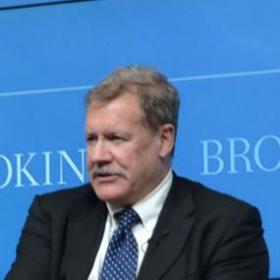
Egypt 2011, Arab Development Report 2002
For his weekly column in New Europe, Greg Austin explores how the Arab Development Report series foreshadowed the Egyptian protests.
The first Arab Development Report (ADR) released in 2002 was a milestone toward the popular protests in Egypt of the last week. It was of course not the cause, but merely a reflection of the need.
The United Nations Development Program (UNDP) commissioned a group of Arab intellectuals to write the 2002 report, the first in an excellent series of five. The latest report (2009) assessed the significance of the first for its having identified three development “deficits” in the region – in the “acquisition of knowledge, political freedoms, and women’s rights”.
The most exciting aspect of the 2002 ADR was its authorship by critical thinkers from the region. As noted in the fifth report in 2009, the analysis of the earlier reports “resonated in Arab countries and around the world”. The contents were not revolutionary but it was fairly clear even in 2002 that the impact would be. The United Nations system had by some miraculous default staked out new ground on the political liberties and personal dignity of Arabs in a way that it had done for no other large multi-national population group ever before.
This was most notable for what it said about women. It called for “complete empowerment of Arab women, taking advantage of all opportunities to build their capabilities and to enable them to exercise those capabilities to the full.”
The indicators for Egypt in the 2002 report showed stark contrasts. It was the most scientifically advanced Arab country, but with a desperately low number of internet users. It had comparatively high life expectancies, but high infant mortality rates. It had a very low level of political participation. Egypt’s female work force figures were among the poorest in the Arab world, and labor productivity was low.
The national statistics for Egypt expressed in percentage terms or per capita are somewhat distorted either by the huge difference between Egypt’s total population (73 million in 2005) or by its demographics compared with those of other Arab countries. More than half of the Arab countries have populations less than ten million, and Egypt has a very different urban/rural balance than many wealthy Arab countries. But the sad fact is that life in Libya and Syria seems better than in Egypt, according to the Human Development Index.
By 2009, the ADR was taking a closer look at the balance between state power and individual development. It noted that there had been a tendency to “focus more on the security of the state than on the security of the people”. Noting that this had worked to ensure the “continuity of the state”, it had “also led to missed opportunities to ensure the security of the human person”. The result was the “bond between state and citizen” was “less strong” than it might otherwise be. Not only did this reduce tolerance and inclusiveness in these countries, but the result has been “an all-too-common sense of limited opportunities and personal insecurity, witnessed in the world’s highest levels of unemployment, deep and contentious patterns of exclusion, and, ultimately strong calls from within for reform.”
The undoing of the Mubarak government can be seen in the deterioration of Egypt’s standing against three key indicators between 1996 and 2007: government effectiveness, the rule of law, and control of corruption. Of some note is that while most Arab governments also showed weaker performance against these indicators in 2007 than a decade earlier, all of the Gulf states (not including Iraq) showed clear improvement.
The 2002 report called for “unleashing the innovative energies of all Arabs, in the context of an enabling social contract.” It said “Great goals require great acts”. We have seen great acts of revolt and defiance. Let us hope for the emergence of that empowering social contract in Egypt.

